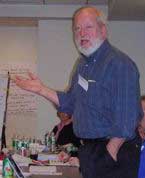[© Copyright. Feel free to link to this blog. Please ask author for permission before copying.]
[Co-Authored: William Bergquist and Agnes Mura]
[Derived from William Bergquist and Agnes Mura, Ten Themes and Variations for Postmodern Leaders and Their Coaches. and from a forthcoming book, William Bergquist and Agnes Mura, Building an Appreciative Organization: Themes and Strategies for Effective Postmodern Leaders, Consultants and Coaches. For information on both books contact Emily Browne, Administrator, Pacific Soundings Press, 3550 Watt Ave. Suite 140, Sacramento, California 95821.]
Theme: Acknowledging the Role of Chaos in Our Postmodern World
Fundamental Question
What might we learn from postmodern theorists, observers and critics as well as contemporary physicists and biologists about the nature of change as it is now occurring in 21st Century societies?
In a 1991 article in Scientific American that has become a classic in the field, Stuart Kauffman introduces a new concept of chaos and order. He describes three different categories or states in which many systems can be placed. One of these states is highly ordered and structured. Kauffman draws an analogy between this state and the solid state that water takes when it is frozen. A second state is highly chaotic. Kauffman equates this state with the gaseous form which water takes when it is evaporating. The third (most interesting) state is one of transition between order and chaos, which Kauffman equates with the liquid state of water. The differentiation between solid, gaseous and liquid networks can be of significant value in setting the context for any discussion of postmodernism in organizations—and, in particular, the irreversibility of many organizational processes. We must look not only at ordered networks—the so-called solid state—and at chaotic networks—the so-called gaseous state—but also at liquid networks that hover on the brink of chaos, if we are to understand and influence our unique postmodern institutions.
The third (liquid) state holds great potential when we examine and seek to understand confusing and often elusive organizational phenomena such as intentions, leadership and communication. Turbulent rivers, avalanches, shifting weather patterns, and other conditions that move between order and chaos typify the liquid state. Liquid systems contain chaotic elements as well as elements of stability. There are both quiet pools and eddies in a turbulent river. Mountain avalanches consist of not only rapidly moving volumes of snow but also stable snow packs on top of which, around which, or onto which the cascading snow moves. Stable and chaotic weather patterns intermingle to form overall climatic patterns on our planet.
The liquid state is one that is filled with edges and shifting boundaries. A liquid, edgy state is also filled with the potential for learning. A liquid system has the capacity to adjust and rework itself into an orderly, solid state. At certain points, however, the solid state (the eddy, the snow pack, or the stable weather pattern) reaches a super-critical state and can no longer adjust to the addition of another change or variant in pattern. At this point the system becomes fluid and an avalanche occurs. Portions of the system take on a very different form, and the system can once again adjust to the addition of a few changes or alterations in pattern. We would suggest that most organizations live on the edge, in the liquid state, poised on the edge of chaos. Furthermore, organizations are dynamic systems that can adjust based on quick and accurate feedback systems. This is first-order change. Yet, at a super-critical stage, organizations can no longer adjust. They can no longer accept any additional change or crisis. The one additional piece of straw has broken the camel’s back. An avalanche begins and the organization changes in a profound manner. This is second-order change. (see our initial description of first and second order change in essay 1.2)
The theory of self-organizing criticality (or weak chaos) and edginess suggests that small events (first order changes) such as a shift in leadership will usually produce only minor alterations in the structure and dynamics of the organization (the snow pack will get a bit wider or a bit higher). However, a change in leadership sometimes will create a major second-order alteration (an avalanche). Furthermore, while the outcomes are dramatically different, Bak and Chen have proposed that the same processes are involved in the initiation of both the minor and major changes, and that the onset of the major event can not be predicted—in part because the same process brings about both outcomes.
The liquid state and the edge are places of leadership and innovation (“the leading edge”). They are settings where things get done—yet often in the context of a very challenging and exhausting environment (what Peter Vail describes as a white water world). Edges have no substance. They come to a point and then disappear. Perhaps this is what the new postmodern edginess is all about—what Milan Kundera calls “the unbearable lightness of being.” We need to learn how to live and work in this new environment of edges. If this is the case, then perhaps we need to listen to the architects and prophets of postmodernism, for they may provide some valuable clues as to how this world might best be faced. These architects and prophets come in many different forms: deconstructionists, feminists, chaos theorists, structuralists. This blog is devoted, in part, to the examination of these postmodernists as they might help inform and revise our assumptions about the nature, purpose and dynamics of those organizations in which we live and work.



 Posted by William Bergquist
Posted by William Bergquist 